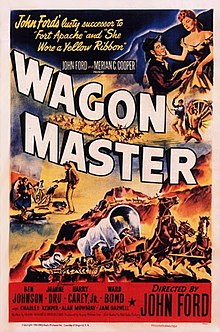
Back Wagonmaster Catalan Wagon Master Welsh Westlich St. Louis German Wagon Master Spanish Wagonmaster – aavikon sankari Finnish Le Convoi des braves French Caravana de paz Galician Wagon Master ID La carovana dei mormoni Italian 幌馬車 (1950年の映画) Japanese
| Wagon Master | |
|---|---|
 1950 theatrical release poster | |
| Directed by | John Ford |
| Written by | Patrick Ford Frank S. Nugent |
| Produced by | John Ford Merian C. Cooper |
| Starring | |
| Cinematography | Bert Glennon (director of photography) |
| Edited by | Jack Murray |
| Music by | Richard Hageman |
Production company | |
| Distributed by | RKO-Radio Pictures Inc. |
Release date |
|
Running time | 86 min. |
| Country | United States |
| Languages | English Navajo Spanish |
Wagon Master is a 1950 American Western film produced and directed by John Ford and starring Ben Johnson, Harry Carey Jr., Joanne Dru, and Ward Bond. The story follows a Mormon pioneer wagon train across treacherous desert to the San Juan River in Utah.[2][3] The film inspired the US television series Wagon Train (1957–1965), which starred Bond until his death in 1960.[4] The film was a personal favorite of Ford himself, who told Peter Bogdanovich in 1967 that "Along with The Fugitive and The Sun Shines Bright, Wagon Master came closest to being what I wanted to achieve."[5] While the critical and audience response to Wagon Master was lukewarm on its release, over the years numerous critics have come to view it as one of Ford's masterpieces.
- ^ "Wagon Master: Detail View". American Film Institute. Retrieved May 18, 2014.
- ^ Cite error: The named reference
Franklinwas invoked but never defined (see the help page). - ^ Cite error: The named reference
Dirkswas invoked but never defined (see the help page). - ^ Cite error: The named reference
Jacksonwas invoked but never defined (see the help page). - ^ Cite error: The named reference
Bogdanovichwas invoked but never defined (see the help page).